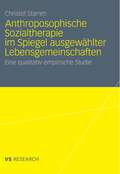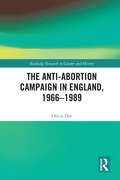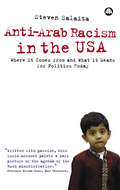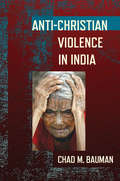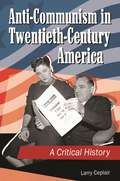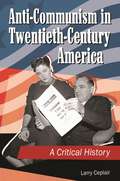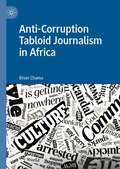- Table View
- List View
Anthroposophische Sozialtherapie im Spiegel ausgewählter Lebensgemeinschaften: Eine qualitativ-empirische Studie
by Christof StammAnthropozentrische Produktionssysteme: Die Neuorganisation der Fabrik zwischen „Lean Production“ und „Sozialverträglichkeit“ (Schriften des Institut Arbeit und Technik #2)
by Volker Eichener Josef Hilbert Josef SchmidAnti-Abortion Activism in the UK: Ultra-sacrificial Motherhood, Religion and Reproductive Rights in the Public Sphere (Emerald Studies in Reproduction, Culture and Society)
by Pam Lowe Sarah-Jane PageDrawing from extensive ethnographic research on abortion debates in public spaces, this book explores the beliefs, motivations and practices of UK anti-abortion activists. Whilst they represent a tiny minority, there is recent evidence of an increase in activism outside UK abortion clinics; faith-based groups regularly organise 'vigils' seeking to deter service users from entering clinics. In response to this, pro-choice groups launched a campaign for buffer-zones around clinics. Although there is overwhelming public support for abortion, it remains an area of public contestation that touches on ideas about bodily autonomy, religious freedom and reproductive rights. Despite being active in the UK since before the 1967 Abortion Act, anti-abortion activism has received little attention. Taking a lived religion approach, Anti-Abortion Activism in the UK explores the sacred and profane commitments of anti-abortion activists and counter-demonstrations outside clinics, examining the contestations over space. The authors argue that as a moral reform social movement, the anti-abortion activists typically frame their activism in terms of risk and abortion harm, but their religiously-informed understanding of ultra-sacrificial motherhood as ‘natural’ for women undermines this framing. Their conservative gender and sexuality attitudes position them culturally as a moral minority. The displays of public religion are also anomalous in a country in which religion is usually seen as a private issue. Their presence outside abortion clinics causes a significant amount of distress, but public support for the establishment of safe zones outside of abortion-service provision is strong and is a proportionate response to safeguard the freedoms of those seeking abortion.
Anti-Abortion Activism in the UK: Ultra-sacrificial Motherhood, Religion and Reproductive Rights in the Public Sphere (Emerald Studies in Reproduction, Culture and Society)
by Pam Lowe Sarah-Jane PageDrawing from extensive ethnographic research on abortion debates in public spaces, this book explores the beliefs, motivations and practices of UK anti-abortion activists. Whilst they represent a tiny minority, there is recent evidence of an increase in activism outside UK abortion clinics; faith-based groups regularly organise 'vigils' seeking to deter service users from entering clinics. In response to this, pro-choice groups launched a campaign for buffer-zones around clinics. Although there is overwhelming public support for abortion, it remains an area of public contestation that touches on ideas about bodily autonomy, religious freedom and reproductive rights. Despite being active in the UK since before the 1967 Abortion Act, anti-abortion activism has received little attention. Taking a lived religion approach, Anti-Abortion Activism in the UK explores the sacred and profane commitments of anti-abortion activists and counter-demonstrations outside clinics, examining the contestations over space. The authors argue that as a moral reform social movement, the anti-abortion activists typically frame their activism in terms of risk and abortion harm, but their religiously-informed understanding of ultra-sacrificial motherhood as ‘natural’ for women undermines this framing. Their conservative gender and sexuality attitudes position them culturally as a moral minority. The displays of public religion are also anomalous in a country in which religion is usually seen as a private issue. Their presence outside abortion clinics causes a significant amount of distress, but public support for the establishment of safe zones outside of abortion-service provision is strong and is a proportionate response to safeguard the freedoms of those seeking abortion.
The Anti-Abortion Campaign in England, 1966-1989 (Routledge Research in Gender and History #36)
by Olivia DeeThis book comprises a history of the anti-abortion campaign in England, focusing on the period 1966-1989, which saw the highest concentration of anti-abortion activity during the twentieth century. It examines the tactics deployed by campaigners in their efforts to overturn the 1967 Abortion Act. Key themes include the influence of religion on attitudes towards sexuality and pregnancy; representations of women and the female body; and the varied, and often deeply contested, attitudes towards the status of the fetus articulated by both anti-abortion and pro-choice advocates during the years 1966-1989.
The Anti-Abortion Campaign in England, 1966-1989 (Routledge Research in Gender and History #36)
by Olivia DeeThis book comprises a history of the anti-abortion campaign in England, focusing on the period 1966-1989, which saw the highest concentration of anti-abortion activity during the twentieth century. It examines the tactics deployed by campaigners in their efforts to overturn the 1967 Abortion Act. Key themes include the influence of religion on attitudes towards sexuality and pregnancy; representations of women and the female body; and the varied, and often deeply contested, attitudes towards the status of the fetus articulated by both anti-abortion and pro-choice advocates during the years 1966-1989.
Anti-American Myths: Their Causes and Consequences
by Arnold BeichmanIn his probing new introduction to Anti-American Myths, which was initially published twenty years ago as Nine Lies About America, Arnold Beichman notes a powerful fact: what makes the United States unique is not only its military power nor its huge economy, nor even its great technological innovations. Rather, what differentiates the nation from virtually all others is that there is no large-scale territorial movement whose sponsors seek to secede from the country and to establish a new nation. And yet, anti-Americanism has characterized a small portion of ideologists whom Beichman refers to as radical egalitarians. These prophets of doom still abound. Everywhere the glib accusations are leveled: America is sick, racist, materialist, aggressive, decadent, and only violent revolution can save it. Even the collapse of the Soviet Union and of socialist regimes in Eastern Europe has not quelled the rhetoric of anti-Americanism. It is Beichman's aim to explain the roots of such persistent opposition to American society as presently constructed. Tom Wolfe in his Foreword shrewdly observes: "This is not a book 'about America'... it is a book that uses the subject of the United States as a device with which to explore the modern intellectual's retrograde habits of mind. Beichman finds nothing particularly amusing about what American intellectuals do to rationality and the English language, let alone the common weal, when they get on the subject of the United States. But I, for one, find his demonstration of the hash these men have made of the mother tongue extremely entertaining." When initially published, Beichman's classic was termed "powerful, persuasive and credible ... a laser beam of fact and reason" by the Los Angeles Times, and a "most valuable antidote to a lot of cliche thinking and cliche thinking and cliche writing" by the New York Times. Edwin McDowell, in his review for the WaH Street Journal reminds the reader that Beichman "is not a rightwinger bent on defining the status quo. .. but unabashedly a man of the left... an important figure in the international trade union movement."Anti-American Myths'' will be of interest to intellectual historians, political scientists, sociologists, and all readers interested in contemporary social and political affairs.
Anti-American Myths: Their Causes and Consequences
by Arnold BeichmanIn his probing new introduction to Anti-American Myths, which was initially published twenty years ago as Nine Lies About America, Arnold Beichman notes a powerful fact: what makes the United States unique is not only its military power nor its huge economy, nor even its great technological innovations. Rather, what differentiates the nation from virtually all others is that there is no large-scale territorial movement whose sponsors seek to secede from the country and to establish a new nation. And yet, anti-Americanism has characterized a small portion of ideologists whom Beichman refers to as radical egalitarians. These prophets of doom still abound. Everywhere the glib accusations are leveled: America is sick, racist, materialist, aggressive, decadent, and only violent revolution can save it. Even the collapse of the Soviet Union and of socialist regimes in Eastern Europe has not quelled the rhetoric of anti-Americanism. It is Beichman's aim to explain the roots of such persistent opposition to American society as presently constructed. Tom Wolfe in his Foreword shrewdly observes: "This is not a book 'about America'... it is a book that uses the subject of the United States as a device with which to explore the modern intellectual's retrograde habits of mind. Beichman finds nothing particularly amusing about what American intellectuals do to rationality and the English language, let alone the common weal, when they get on the subject of the United States. But I, for one, find his demonstration of the hash these men have made of the mother tongue extremely entertaining." When initially published, Beichman's classic was termed "powerful, persuasive and credible ... a laser beam of fact and reason" by the Los Angeles Times, and a "most valuable antidote to a lot of cliche thinking and cliche thinking and cliche writing" by the New York Times. Edwin McDowell, in his review for the WaH Street Journal reminds the reader that Beichman "is not a rightwinger bent on defining the status quo. .. but unabashedly a man of the left... an important figure in the international trade union movement."Anti-American Myths'' will be of interest to intellectual historians, political scientists, sociologists, and all readers interested in contemporary social and political affairs.
Anti-Americanism in European Literature (Studies in European Culture and History)
by J. GulddalPursues the hypothesis that fictional literature has been instrumental in the development and dissemination of European anti-Americanism from the early 1800s to today. Focusing on Britain, France and Germany, it offers analyses of a range of canonical literary works in which resentful hostility towards the United States is a predominant feature.
Anti-Arab Racism in the USA: Where It Comes From and What It Means For Politics Today
by Steven SalaitaToday is a difficult time to be both Arab and American. Since 9/11 there has been a lot of criticism of America’s involvement in the middle east. Yet there has been little analysis of how America treats citizens of Arab or middle eastern origin within its own borders. *BR**BR*Steven Salaita explores the reality of Anti-Arab racism in America. He blends personal narrative, theory and polemics to show how this deep-rooted racism affects everything from legislation to cultural life, shining a light on the consequences of Anti-Arab racism both at home and abroad.*BR**BR*The book shows how ingrained racist attitudes can be found within the progressive movements on the political left, as well as the right. Salaita argues that, under the guise of patriotism, Anti-Arab racism fuels support for policies such as the Patriot Act.
Anti-Arab Racism in the USA: Where It Comes From and What It Means For Politics Today
by Steven SalaitaToday is a difficult time to be both Arab and American. Since 9/11 there has been a lot of criticism of America’s involvement in the middle east. Yet there has been little analysis of how America treats citizens of Arab or middle eastern origin within its own borders. *BR**BR*Steven Salaita explores the reality of Anti-Arab racism in America. He blends personal narrative, theory and polemics to show how this deep-rooted racism affects everything from legislation to cultural life, shining a light on the consequences of Anti-Arab racism both at home and abroad.*BR**BR*The book shows how ingrained racist attitudes can be found within the progressive movements on the political left, as well as the right. Salaita argues that, under the guise of patriotism, Anti-Arab racism fuels support for policies such as the Patriot Act.
Anti-asiatischer Rassismus und gender: Eine qualitativ-biographische Studie (BestMasters)
by Anna-Natalia KochDieses Buch beschäftigt sich mit der Frage, wie asiatisch gelesene Menschen (genderbezogene) Rassismuserfahrungen im biographischen Verlauf deuten. Unter der reflexiven Grounded Theory Methodologie wurden biographisch-narrative Interviews mit 20 asiatisch gelesenen Personen durchgeführt. Die empirischen Daten zeigen, wie anti-asiatischer Rassismus von Betroffenen subjektiv kategorisiert und erlebt wird. Die Teilnehmenden nehmen außerdem eine Verschränkung rassistischer vergeschlechtlichter Zuschreibungen insbesondere über rassistische Weiblichkeits- und Männlichkeitskonstruktionen wahr.
The Anti-Authoritarian Personality: International Series of Monographs In, Experimental Psychology
by William P. KremlThe Anti-Authoritarian Personality is a seven-chapter book that first explains the anti-authoritarian personality. Subsequent chapter discusses the authoritarian model. Other chapters detail the order, power, impulse, and introspection. The authoritarian model in politics is also described.
Anti-Black Racism in Early Modern English Drama: The Other “Other” (Routledge Studies in Renaissance Literature and Culture)
by Matthieu ChapmanThis is the first book to deploy the methods and ensemble of questions from Afro-pessimism to engage and interrogate the methods of Early Modern English studies. Using contemporary Afro-pessimist theories to provide a foundation for structural analyses of race in the Early Modern Period, it engages the arguments for race as a fluid construction of human identity by addressing how race in Early Modern England functioned not only as a marker of human identity, but also as an a priori constituent of human subjectivity. Chapman argues that Blackness is the marker of social death that allows for constructions of human identity to become transmutable based on the impossibility of recognition and incorporation for Blackness into humanity. Using dramatic texts such as Othello, Titus Andronicus, and other Early Modern English plays both popular and lesser known, the book shifts the binary away from the currently accepted standard of white/non-white that defines "otherness" in the period and examines race in Early Modern England from the prospective of a non-black/black antagonism. The volume corrects the Afro-pessimist assumption that the Triangle Slave Trade caused a rupture between Blackness and humanity. By locating notions of Black inhumanity in England prior to chattel slavery, the book positions the Triangle Trade as a result of, rather than the cause of, Black inhumanity. It also challenges the common scholarly assumption that all varying types of human identity in Early Modern England were equally fluid by arguing that Blackness functioned as an immutable constant. Through the use of structural analysis, this volume works to simplify and demystify notions of race in Renaissance England by arguing that race is not only a marker of human identity, but a structural antagonism between those engaged in human civil society opposed to those who are socially dead. It will be an essential volume for those with interest in Renaissance Literature and Culture, Shakespeare, Contemporary Performance Theory, Black Studies, and Ethnic Studies.
Anti-Black Racism in Early Modern English Drama: The Other “Other” (Routledge Studies in Renaissance Literature and Culture)
by Matthieu ChapmanThis is the first book to deploy the methods and ensemble of questions from Afro-pessimism to engage and interrogate the methods of Early Modern English studies. Using contemporary Afro-pessimist theories to provide a foundation for structural analyses of race in the Early Modern Period, it engages the arguments for race as a fluid construction of human identity by addressing how race in Early Modern England functioned not only as a marker of human identity, but also as an a priori constituent of human subjectivity. Chapman argues that Blackness is the marker of social death that allows for constructions of human identity to become transmutable based on the impossibility of recognition and incorporation for Blackness into humanity. Using dramatic texts such as Othello, Titus Andronicus, and other Early Modern English plays both popular and lesser known, the book shifts the binary away from the currently accepted standard of white/non-white that defines "otherness" in the period and examines race in Early Modern England from the prospective of a non-black/black antagonism. The volume corrects the Afro-pessimist assumption that the Triangle Slave Trade caused a rupture between Blackness and humanity. By locating notions of Black inhumanity in England prior to chattel slavery, the book positions the Triangle Trade as a result of, rather than the cause of, Black inhumanity. It also challenges the common scholarly assumption that all varying types of human identity in Early Modern England were equally fluid by arguing that Blackness functioned as an immutable constant. Through the use of structural analysis, this volume works to simplify and demystify notions of race in Renaissance England by arguing that race is not only a marker of human identity, but a structural antagonism between those engaged in human civil society opposed to those who are socially dead. It will be an essential volume for those with interest in Renaissance Literature and Culture, Shakespeare, Contemporary Performance Theory, Black Studies, and Ethnic Studies.
Anti-Catholicism in Britain and Ireland, 1600–2000: Practices, Representations and Ideas (Histories of the Sacred and Secular, 1700–2000)
by Claire Gheeraert-Graffeuille Geraldine VaughanThis edited collection brings together varying angles and approaches to tackle the multi-dimensional issue of anti-Catholicism since the Protestant Reformation in Britain and Ireland. It is of course difficult to infer from such geographically and historically diverse studies one single contention, but what the book as a whole suggests is that there can be no teleological narration of anti-Catholicism – its manifestations were episodic, more or less rooted in common worldviews, and its history does not end today.
Anti-Christian Violence in India (Religion and Conflict)
by Chad M. BaumanDoes religion cause violent conflict, asks Chad M. Bauman, and if so, does it cause conflict more than other social identities? Through an extended history of Christian-Hindu relations, with particular attention to the 2007–2008 riots in Kandhamal, Odisha, Anti-Christian Violence in India examines religious violence and how it pertains to broader aspects of humanity. Is "religious" conflict sui generis, or is it merely one species of intergroup conflict? Why and how might violence become an attractive option for religious actors? What explains the increase in religious violence over the last twenty to thirty years?Integrating theories of anti-Christian violence focused on politics, economics, and proselytization, Anti-Christian Violence in India additionally weaves in recent theory about globalization and, in particular, the forms of resistance against Western secular modernity that globalization periodically helps to provoke. With such theories in mind, Bauman explores the nature of anti-Christian violence in India, contending that resistance to secular modernities is, in fact, an important but often overlooked reason behind Hindu attacks on Christians. Intensifying the widespread Hindu tendency to think of religion in ethnic rather than universal terms, the ideology of Hindutva, or "Hinduness," explicitly rejects both the secular privatization of religion and the separability of religions from the communities that incubate them. And so, with provocative and original analysis, Bauman questions whether anti-Christian violence in contemporary India is really about religion, in the narrowest sense, or rather a manifestation of broader concerns among some Hindus about the Western sociopolitical order with which they associate global Christianity.
Anti-Communism in Twentieth-Century America: A Critical History
by Larry CeplairThis compelling, critical analysis of anti-communism illustrates the variety of anti-Communist styles and agendas, thereby making a persuasive case that the "threat" of domestic communism in Cold War America was vastly overblown.In the United States today, communism is an ideology or political movement that barely registers in the consciousness of our nation. Yet merely half a century ago, "communist" was a buzzword that every citizen in our nation was aware of—a term that connoted "traitor" and almost certainly a characterization that most Americans were afraid of.Anti-Communism in Twentieth-Century America: A Critical History provides a panoramic perspective of the types of anti-communists in the United States between 1919 and the collapse of the Soviet Union. It explains the causes and exceptional nature of anti-communism in the United States, and divides it into eight discrete categories. This title then thoroughly examines the words and deeds of the various anti-Communists in each of these categories during the three "Red Scares" in the past century. The work concludes with an unapologetic assessment of domestic anti-communism. This book allows readers to more fully comprehend what the anti-communists meant with their rhetoric, and grasp their impact on the United States during the 20th century and beyond—for example, how anti-communism has reappeared as anti-terrorism.
Anti-Communism in Twentieth-Century America: A Critical History
by Larry CeplairThis compelling, critical analysis of anti-communism illustrates the variety of anti-Communist styles and agendas, thereby making a persuasive case that the "threat" of domestic communism in Cold War America was vastly overblown.In the United States today, communism is an ideology or political movement that barely registers in the consciousness of our nation. Yet merely half a century ago, "communist" was a buzzword that every citizen in our nation was aware of—a term that connoted "traitor" and almost certainly a characterization that most Americans were afraid of.Anti-Communism in Twentieth-Century America: A Critical History provides a panoramic perspective of the types of anti-communists in the United States between 1919 and the collapse of the Soviet Union. It explains the causes and exceptional nature of anti-communism in the United States, and divides it into eight discrete categories. This title then thoroughly examines the words and deeds of the various anti-Communists in each of these categories during the three "Red Scares" in the past century. The work concludes with an unapologetic assessment of domestic anti-communism. This book allows readers to more fully comprehend what the anti-communists meant with their rhetoric, and grasp their impact on the United States during the 20th century and beyond—for example, how anti-communism has reappeared as anti-terrorism.
Anti-Communist Minorities in the U.S.: Political Activism of Ethnic Refugees
by I. ZakeTaking a new look at two controversial topics, American anti-Communism and the Cold War, this book reveals the little known history of anti-Communism in the US from the point of view of ethnic refugee/émigré groups, and also offers insight into the lives of minority groups that have hitherto not received scholarly attention.
Anti-Corruption and its Discontents: Local, National and International Perspectives on Corruption in Papua New Guinea
by Grant W. WaltonThe fight against corruption is now a core part of development policy and practice. Some call these efforts a ‘war on corruption’. What does this so-called ‘war’ mean for developing countries? And how do international perspectives on corruption relate to local and national concerns? This book examines the relevance of anti-corruption discourse in Papua New Guinea (PNG), one of the most culturally rich and ‘corrupt’ countries on earth. Despite increased international, national and local efforts to address corruption over the past two decades, many fear that levels of corruption continue to rise largely unabated. Some believe that the mismatch between international, national and local assumptions regarding the nature of corruption and how it should be addressed is at the heart of the issue. International anti-corruption initiatives stress ‘zero-tolerance’ and try to strengthen formal state-based institutions. However, many people in PNG are more concerned about maintaining social relationships than following state laws and rules. This book critically examines the implications of the anti-corruption agenda and the collision of international, national and local perspectives. In doing so it provides a diagnostic on international assumptions about corruption and how it should be fought in developing countries, offering surprising and important lessons. This book is essential reading for scholars and students of Development Studies, Geography, Political Studies and Economics, as well as practitioners and policy makers working in development.
Anti-Corruption and its Discontents: Local, National and International Perspectives on Corruption in Papua New Guinea
by Grant W. WaltonThe fight against corruption is now a core part of development policy and practice. Some call these efforts a ‘war on corruption’. What does this so-called ‘war’ mean for developing countries? And how do international perspectives on corruption relate to local and national concerns? This book examines the relevance of anti-corruption discourse in Papua New Guinea (PNG), one of the most culturally rich and ‘corrupt’ countries on earth. Despite increased international, national and local efforts to address corruption over the past two decades, many fear that levels of corruption continue to rise largely unabated. Some believe that the mismatch between international, national and local assumptions regarding the nature of corruption and how it should be addressed is at the heart of the issue. International anti-corruption initiatives stress ‘zero-tolerance’ and try to strengthen formal state-based institutions. However, many people in PNG are more concerned about maintaining social relationships than following state laws and rules. This book critically examines the implications of the anti-corruption agenda and the collision of international, national and local perspectives. In doing so it provides a diagnostic on international assumptions about corruption and how it should be fought in developing countries, offering surprising and important lessons. This book is essential reading for scholars and students of Development Studies, Geography, Political Studies and Economics, as well as practitioners and policy makers working in development.
Anti-Corruption in International Development (Routledge Corruption and Anti-Corruption Studies)
by Ingrida KerusauskaiteCorruption is linked to a wide range of developmental issues, including undermining democratic institutions, slowing economic development and contributing to government instability, poverty and inequality. It is estimated that corruption costs more than 5 per cent of global GDP, and that more than one trillion US dollars are paid in bribes each year. This book unpacks the concept of corruption, its political and ethical influences, its measurement, commitments to combat corruption and ways that this is being attempted. Building on the research on the nature, causes and consequences of corruption, this book analyses international anti-corruption interventions in particular. It discusses approaches to focus efforts to tackle corruption in developing countries on where they are most likely to be successful. The efforts of the UK are considered as a detailed case study, with comparisons brought in as necessary from other countries’ and multilateral institutions’ anti-corruption efforts. Bridging a range of disciplines, Anti-Corruption in International Development will be of interest to students and scholars of international development, public administration, management, international relations, politics and criminal justice.
Anti-Corruption in International Development (Routledge Corruption and Anti-Corruption Studies)
by Ingrida KerusauskaiteCorruption is linked to a wide range of developmental issues, including undermining democratic institutions, slowing economic development and contributing to government instability, poverty and inequality. It is estimated that corruption costs more than 5 per cent of global GDP, and that more than one trillion US dollars are paid in bribes each year. This book unpacks the concept of corruption, its political and ethical influences, its measurement, commitments to combat corruption and ways that this is being attempted. Building on the research on the nature, causes and consequences of corruption, this book analyses international anti-corruption interventions in particular. It discusses approaches to focus efforts to tackle corruption in developing countries on where they are most likely to be successful. The efforts of the UK are considered as a detailed case study, with comparisons brought in as necessary from other countries’ and multilateral institutions’ anti-corruption efforts. Bridging a range of disciplines, Anti-Corruption in International Development will be of interest to students and scholars of international development, public administration, management, international relations, politics and criminal justice.
Anti-Corruption Tabloid Journalism in Africa
by Brian ChamaThis book studies the role of tabloid newspapers in exposing corruption and embezzlement in Africa. It makes a timeless, original contribution to the field by examining tabloid journalism practices and anti-corruption forces that have not yet been introduced to Afrocentric journalism scholarship. Defining tabloid journalism practice as an infotainment genre, the book examines corruption exposure by tabloids in Arabic, Portuguese and French speaking countries across Africa, making it a unique addition to the field. In doing so, it also builds an understanding of the evolution of anti-corruption tabloid journalism in Africa and gains insights into the relationship between the anti-corruption actions of the state and the anti-corruption reporting by tabloid journalists focusing on major corruption scandals. Providing evidence of the successes and struggles of journalistic practice in Africa, the book concludes by providing a synthesis of the emerging patterns and divergences from the cases analysed, looking to the future of corruption in the continent and the role of tabloid journalism in uncovering and challenging it.
